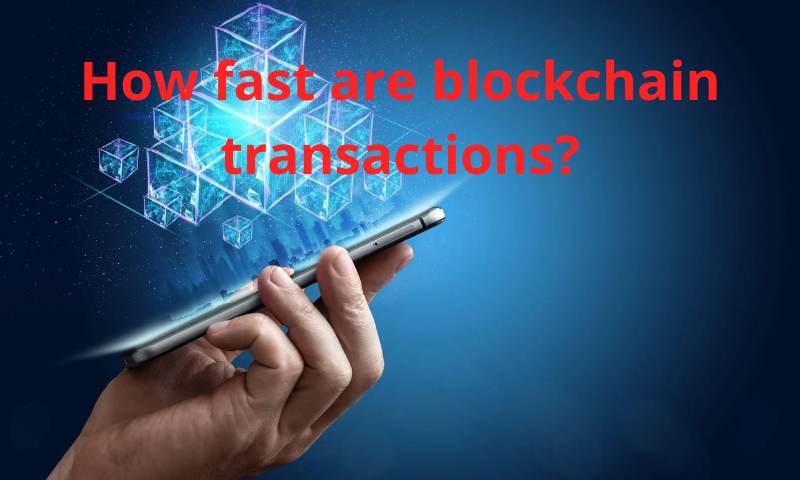Blockchain Transactions Revealed: Are They Swift Enough for Modern Needs?
Peek into the pace of the digital era, and a pressing question arises: How fast are blockchain transactions? In the race to outdo traditional banking, blockchain technology gloats about its speed. But let’s unpack this claim. Sure, it slashes the wait times linked to old-school transactions, but when it comes to handling loads of data, does it maintain its speedy reputation? This deep dive into transaction velocity will not just feed your curiosity but arm you with clarity on whether blockchains cut the mustard.(137 words)
Understanding Blockchain Transaction Speed
What Determines the Velocity of Transactions
Ever wonder why some blockchain transactions zip while others crawl? It’s all about rules and roads. Like cars on a highway, crypto moves fast when the road’s clear and rules are smooth. Here’s the scoop on what makes or breaks the speed.
First up, the blockchain itself. Just as more lanes help traffic move, more data a blockchain can handle at once means quicker moves for our crypto. We call this “throughput,” and it’s key in measuring how many trades a system can do. Next, there’s block time – the seconds it takes for a new set of trades to join the chain. Quicker block time equals faster trades.
Now let’s talk about the list that holds all the trades waiting – we call this the “mempool.” A stuffed mempool means some trades must wait, just like a traffic jam.
Don’t forget about the actual rules for adding trades to the chain. These rules, known as “consensus mechanisms,” can speed up or slow down the process. “Proof of Work” (PoW), the old-school way, takes more time. The newer “Proof of Stake” (PoS) method can hustle them way faster.
Finally, we’ve got to mention the coin’s worth. Yep, it matters, because higher worth can mean more people want to trade, and that can slow things down a bit. Plus, the fees you pay – “gas fees” – can also affect how fast your trade goes through.
The Transaction Per Second (TPS) Metric
Talking ’bout how speedy blockchain is, we rely on a cool number: TPS, or transactions per second. This tells us just how many trades the system can handle in a snap. High TPS means a swift system, while low TPS can mean you’re waiting around for your turn.
Let’s break it down. When we hash it out, the big names like Bitcoin might do about 7 trades a second. Not super fast, especially when we see others pulling hundreds or even thousands at the same time. That’s because each one has different block times and throughput limits.
But don’t just look at TPS – the real deal is about the average confirmation time. That’s how long it takes for a trade to be fully locked in and done. The quick transactions are cool, but if the wait to confirm them is long, what’s the point?
We see the heavyweights like Bitcoin and Ethereum work hard to up their game. They roll out things like the “Lightning Network” for Bitcoin to do trades off the main chain. This helps to keep the traffic moving fine.
So, smart folks in the crypto world look at all of these parts – throughput, block time, and such – to figure out the real pace. They’re hunting for the sweet spot where trades fly without breaking the bank or clogging the system. That’s where new tech and systems come in, but more on that later.
Comparing Major Cryptocurrencies and Their Speeds
Bitcoin Transaction Time vs. Ethereum Processing Speed
Let’s talk about speed on two big players: Bitcoin and Ethereum. How fast do they go? Bitcoin’s pace can be a bit slow. Each block takes about 10 minutes. It makes you wait. Ethereum is quicker, usually seconds or a few minutes for a block.
These times can change, though. A lot depends on traffic. Bitcoin might take an hour or more when it’s busy. That’s because Bitcoin uses a method called Proof of Work (PoW). It’s a bit of a slowpoke but super secure. Ethereum is also on PoW right now. But guess what? They’re planning a big move to Proof of Stake (PoS). It’s like switching from an old bus to a fast train. PoS will make Ethereum zoom even faster!
Let’s dig deeper into why Bitcoin sometimes makes you sit tight. This coin likes to check things a lot. It’s because of its block time duration and the checks it runs. These checks are good for safety but put the brakes on speed. And when many people want to make moves on the blockchain, it can get as crowded as a theme park on a sunny day. That means delays.
Now Ethereum, even though it’s faster, it too can hit a traffic jam. It can process more actions per second, but more folks use it, too. It’s like having a faster car but more cars on the road. What about gas fees? Ah, they can get high when it’s busy. It’s like paying more for a fast pass at the theme park.
Examining Altcoin Transfer Times for Emerging Currencies
You’ve got loads of new players in the game, and they’re not all the same. Some of these altcoins are super fast! It’s like they’ve had ten cups of coffee. They can zip around because they’re made that way. They use new methods to check the moves on their chains, and that can cut down wait times a lot.
Many have names that sound like space codes – like XRP or Cardano. They’re built for speed. Some can settle a move in seconds. Yes, you heard that right. Seconds. Why? They use different ways of checking things. Some don’t go through every check on every computer. It’s like when your mom only needs one look at your homework to know it’s A+.
Plus, these new coins often use PoS or similar speedy ways to agree on what’s what. It’s like everyone at the table saying “yes” at the same time. It makes things fly. And with less folks using these coins, fewer cars are on the road. That means they can keep going fast, even when everyone wants to move their money.
So you see, speed in the crypto world is not just about fast or slow. It’s about how it gets the job done. And with technology always on the move, we might just see a day where every coin is speedy. But for now, we need to choose what works best for us – safety with a bit of a wait, or speed with a zip. Choose what suits your needs!
Remember, blockchain is like a wild garden. It’s still growing and changing. Every day brings a new surprise. Keep your eyes on the sky. Who knows what flying car of a coin might zoom by next!
Overcoming Network Delays: Scalability Solutions
Layer 1 Versus Layer 2 Solutions and Their Impact
When we talk about making blockchains fast, we often hit a wall: scalability. Scalability is just a fancy word for how much a blockchain can handle at once. Bitcoin and Ethereum, the big guys of the crypto world, struggle with this. They’re like old computers trying to run the latest games—they just can’t keep up.
But here’s the kicker—Layer 1 and Layer 2 solutions are the cheat codes needed to boost speed. Layer 1 changes the game’s rules; it tweaks the blockchain’s core, making it natively faster. For Bitcoin, think of it as turning into a super Bitcoin, able to handle more at once.
Now, Layer 2 is like adding a turbo button; it builds on top of the blockchain instead of changing it. It’s like creating shortcuts for transactions to zip through without clogging up the main road. Layer 2 solutions make it so you can do a lot without waiting ages for your turn.
These solutions are why you’ll hear about the Lightning Network. This network lets Bitcoin transactions happen away from the main blockchain, making them super fast. It’s like having a VIP pass at a crowded concert; you skip the line and get right to the action.
The Role of Sidechains and Off-Chain Transactions in Enhancing Speed
Sidechains come into play when main chain get crowded. They are like side streets that cars can take when the highway is jammed. These sidechains let certain transactions happen on a different blockchain, speeding up everything. They handle the extra traffic so the main road stays clear.
Off-chain transactions are cool too. They say, “Why not take some stuff off the blockchain?” This means transactions happen somewhere else, and the blockchain only gets an update at the end. It’s like making a bunch of deals during the day and only telling the blockchain once you’re done.
By using sidechains and off-chain tricks, the main blockchain stays swift. More people can use it without it dragging its feet. This is a big deal for businesses and folks who need their crypto moves to happen fast. Imagine sending money to a friend and they get it before you can even say “blockchain”.
Now, why don’t we snap these solutions into every blockchain out there? Well, each fix comes with its own toolkit, and some blockchains might need different tools. The goal is to find the perfect match to make each blockchain zoom like a race car. This is the work that experts like me wake up excited about every day.
All this tech talk boils down to one thing: we want our digital bucks moving faster without causing a traffic jam. And from where I’m standing, the future of blockchain looks as fast as a rocket—ready to take off and not just for sending a few Bitcoins here or there. We’re talking about handling the massive flow of money swirling around the globe. And with Layer 1, Layer 2, sidechains, and off-chain magic, that future isn’t just a dream—it’s right around the corner.
Future-Proofing Blockchain Efficiency
The Shift to Faster Consensus Mechanisms: PoS and DPoS
You’ve heard that blockchain is the future. But how fast can it really go? Let’s dig in to find out! The key to blockchain speed is in its consensus mechanisms. This is how all the computers agree on the state of the blockchain. We used to have Proof of Work (PoW). It’s secure but slow and uses a lot of energy. Now, a big change is happening!
Proof of Stake (PoS) and Delegated Proof of Stake (DPoS) are the new sheriffs in town. They don’t need miners solving puzzles. Instead, coin owners create new blocks and secure the network. Think of it like a game where holding coins gives you a chance to play and earn rewards.
This switch can mean a big leap in transaction speed. Bitcoin, with PoW, processes about 7 transactions a second. That’s slower than a snail in a race with a cheetah! Ethereum is moving to PoS and aims to leave that snail way behind. With PoS, the Ethereum blockchain will work faster and use less power.
Now, DPoS takes it up a notch. It lets people vote for a few trusted nodes to do the heavy lifting. This can really speed things up. Block time is the time it takes to make new blocks. DPoS can shorten this down to seconds!
But why does all this matter? Less time in block making means more time doing transactions. And that’s what we need for buying and sending money around the world, fast!
Real-Time Blockchain Transactions and Instant Payment Systems
Real-time transactions on blockchain are what we’re all waiting for. We want to send crypto just like we send texts, quick and easy. This is where instant payment systems come in.
The Lightning Network is one such solution. It lets folks do Bitcoin transactions super fast and with tiny fees. It works like a bar tab. You start a tab with someone, do a bunch of transactions, and settle up later, all at once. This means less work for the main Bitcoin blockchain, so less waiting around.
And it’s not just for Bitcoin. There are other instant pay systems out there for other cryptocurrencies. They all aim to make sending digital money fast, like real cash in hand but way cooler.
Why isn’t everyone using blockchain if it’s so great? Well, there’s a problem called network congestion. Too many people trying to use the blockchain at once can slow it down. And then there’s transaction delay because everyone’s waiting in line. But with these new systems, we can skip the line and move right along.
Even though it’s getting better, speeding up transactions is key for blockchain to really take off. Think shops, online games, and sending cash to friends fast. With faster blockchain, that future is just around the corner! So let’s keep our eyes peeled, because with every tick of the clock, blockchain is getting closer to matching our speedy, modern needs.
In this post, we dug into how blockchain transactions move fast or get stuck. We looked at what decides if they zip or drag, like the TPS measure. We then matched big names like Bitcoin and Ethereum to see who wins in speed, and didn’t forget the new kid altcoins either.
We tackled real fixes for slow networks, like Layer 1 and Layer 2 tweaks and how side stuff like sidechains can make things zippy. Last, we eyed up the future with smart new ways to agree, like PoS and DPoS, and peeked at instant pay setups.
My final say? Speed matters, but so do smarts. With sharp tech and wise choices, blockchain can stay fast and meet our needs. We’re steering towards a world where waiting for money to move is old news. Keep an eye on this space; it’s only going to get quicker and better.
Q&A :
How Long Does a Blockchain Transaction Take?
The duration of a blockchain transaction can vary widely depending on several factors including the specific blockchain network, the current network traffic, and the transaction fees paid. On average, Bitcoin transactions can take from 10 minutes to an hour, while transactions on the Ethereum network can take from a few seconds to several minutes. It’s important to note that during times of high network usage, transactions can take longer.
What Factors Affect Blockchain Transaction Speed?
Several factors can impact the speed of blockchain transactions. These include:
- Network congestion: Higher volumes of transactions on the network can lead to longer confirmation times.
- Transaction fees: Transactions with higher fees typically get prioritized by miners and can be confirmed faster.
- Block time: The time it takes to mine a new block can influence transaction speed. Different blockchains have different block times.
- Network scalability: Some blockchains are designed to handle more transactions per second than others, affecting transaction speeds.
Is There a Difference in Speed Between Different Blockchains?
Yes, there is a significant difference in speed between different blockchains. For instance, Bitcoin’s blockchain processes around 4-5 transactions per second with a block time of about 10 minutes, while Ethereum handles roughly 15-30 transactions per second with block times around 13-15 seconds. Other blockchains like Ripple (XRP) can handle up to 1,500 transactions per second with negligible transaction time, showcasing a vast disparity in transaction speeds.
Can Blockchain Transactions Be Instant?
Some blockchains offer near-instant transactions due to their consensus mechanisms and network design. For example, blockchains that use proof of stake (PoS) or directed acyclic graph (DAG) technology can sometimes offer faster transaction times compared to those using proof of work (PoW). However, even with these technologies, the term “instant” can be relative as there is usually a brief delay while the transaction is being confirmed by the network.
How Can I Speed Up My Blockchain Transaction?
To speed up your blockchain transaction, you can:
- Increase the transaction fee: Higher fees can give miners a greater incentive to prioritize and confirm your transaction faster.
- Use a blockchain with faster transaction speeds: Choosing a blockchain known for its speed may lead to quicker transactions.
- Transact during off-peak hours: Submitting transactions when the network is less congested can result in faster confirmations.
- Services like Bitcoin’s Lightning Network: Using layer 2 solutions or off-chain channels that facilitate quicker transactions can also be an effective method.


